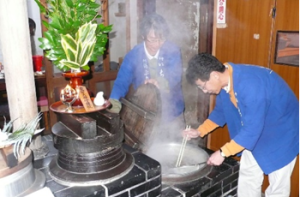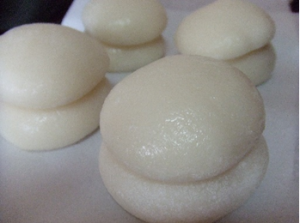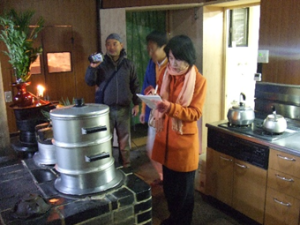(日本語) お餅と日本人 1
 January 1, 2012: Ichiwa makes zoni in an Okdosan’s pot |

January 1, 2012: Ichiwa’s New Year January |
|

December 29, 2011 |

New Year’s Day interview on January 1, 2012 |
Yoshie Doi
The members of Kyo-Suzume’s Okudosan Miraishu have two shops that sell mochi. The owner and the proprietress of Aburimochi Ichimonjiya Kazusuke, and the owner of Tenjindo. Both shops use Okudosan. Aburimochi Ichimonjiya Kazusuke is located on the approach to Imamiya Shrine, and Tenjindo is located in front of the east gate of Kitano Tenmangu Shrine.
Aburimochi Ichimonjiya Kazusuke’s tea shop is the oldest surviving tea shop in the world. It was founded in 1000 AD (Choho 2). Since the Turkish cafe was closed due to the COVID-19 pandemic, Aburimochi Ichimonji Kazusuke’s tea shop has been serving only one type of tea in the same place and with the same recipe in Kyoto, and the well water and the okudosan have been handed down for over a thousand years.
The head of the family explains, “The origins of Aburimochi are said to date back to when the first Ichimonjiya Kazusuke offered okachin (kachimochi) that had been offered at Koryuji Temple (now abandoned) to a new shrine, Imamiya Shrine. The origins of Aburimochi can be traced back to Koryuji Temple, where people would skewer and roast the leftover kachimochi that had been donated at a festival to ward off epidemics.
Aburimochi Ichiwa was founded in the Heian period, in the year 1000. It is a family business that is dedicated to the gods, as it is offered to them and then taken away. It is run under the concept of being an annex to the shrine, so the men work outside and the women manage the store.
That’s why we’ve maintained an attitude of service since the establishment. We even served food during the Onin War, and everyone ate it. Because it’s a family business run by a god, we do cash business based on the number of plates customers request. Aburimochi Ichiwa is also described in the landscapes of Makuranososhi and Gemjimonogatari.
Looking back into history, it is said that rice cultivation techniques were introduced to Japan during the Jomon period, and so was mochi. At the time, red rice was used, rather than the white variety we see today. Red rice is very sticky, and when cooked, it becomes chewy and easy to form, so it developed as an offering to the gods.
Earthenware steamers have been discovered in the latter half of the Kofun period, and it appears that mochi was made in a manner similar to that used today.
It has long been a custom to offer Kagami mochi to the god of the New Year, welcome him on New Year’s Day, and then receive some of the Kagami mochi as “hand-me-downs” after he has departed. This is the Kagami-biraki ceremony, which takes place on January 11th nationwide, but in Kyoto it is held on January 4th and in the Kansai region on January 15th. On this day, fire festivals called “Dondon-yaki,” “Dondo-yaki,” and “Sagicho” are held, and New Year decorations are disposed of.
The name Kagami mochi began to be used from the Kamakura to Muromachi periods, but in the Heian period it was called Mochi Kagami. Mirrors are thought to have spiritual powers, and Kagami mochi was created by shaping mochi as a mirror in which gods reside.
Kagami mochi, which is displayed during New Year’s, is said to be the residence of a visiting Toshigami-sama (god of the New Year), and one theory is that its shape resembles the heart, where the human soul resides, and it is imbued with prayers for harmonious relationships between people.
Since the full moon is also known as the “Mochizuki,” it has been believed that praying to Kagami mochi will make your wishes come true.
During the Showa era, there was a manju shop called “Mochizuki” just up the street from Kiyamachi Sanjo. My father loved the “Mochizuki” there and often bought them as souvenirs, and I remember eating them since I was a child. The shop has now gone out of business.
It is said that this full moon shaped rice cake came to be called Kagami mochi because it resembles the shape of a bronze mirror, one of the Emperor’s “Three Sacred Treasures.”
The end of document
Translated by Masami Otani
